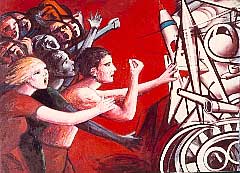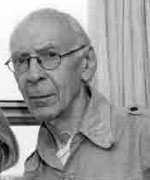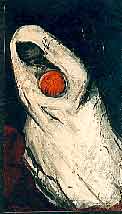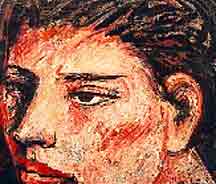|

|
Welcome
to the website of artist Philip Stein, aka Estaņo
/
1919 - 2009.
Assistant
to David Alfaro Siqueiros from 1948 to 1958
mexicanmuralschool.com
|
|
An
interview with American Artist, Philip Stein - aka Estaņo
Interview
with Philip Stein conducted by artist Mark
Vallen on February 2004.
|
Statement
by interviewer, Mark Vallen
- "Philip Stein,
also known as Estaņo,
was a
living link to one of the world's most influential artistic
schools, the Mexican Muralist Movement. Stein's passionate
and detailed biography of David
Alfaro Siqueiros
was based on the first hand experience of having worked
alongside the maestro for ten years as an assistant
artist. The Mexican Cultural Commission proclaimed Stein's,
Siqueiros
- His life and Works,
the definitive biography on the great revolutionary
artist. But the book is also an invaluable tool that
leads to a complete understanding of the Mexican Mural
Movement, what led to it, what sustained it, and its
impact on world history. An
unrepentant radical living in reactionary times, Stein
reminded us all that the muralists were
actually political
militants who held uncompromising opinions on art and
everything else. Like
it or not, Stein delivered his view of history as only
an active participant can. A fabulous artist in his
own right whose paintings have been collected and shown
around the world, I am honored that Estaņo
consented
to this exclusive interview with me."
|
|
|
|
Quetzalcoatl
- Estaņo 1977
Acrylic on Masonite |
|
Question)
The Muralistas and their works were an inspiration to
people all over the world. There is no doubt that the
Chicano Arts Movement of the 1970s was profoundly influenced
by the Mexican School of painters. In your view, what
is the actual legacy of the Mexican School and what
can today's young people learn from it?
Answer)
Certainly the murals in Mexico plus the works of the
Big Three ("Los Tres" - Rivera, Siqueiros,
Orozco) in the United States were a powerful inspiration
to the young artists of the U.S. The Chicano Art Movement
understood and felt deeply the social commitment that
the Mexican muralists had instilled in their art and
they, the North Americans, attempted in no uncertain
way to move forward on the road that had been shown
to them by the Mexicans. This has been the legacy of
the Mexican School. Art as a weapon has been the basis
of the innumerable street murals of the Chicano Art
Movement.
|
|
Question)
The
post modern school now dominating the international
art world has given us an inward-looking and socially
disconnected art. Today a pile of rocks, fecal matter,
or an artist screaming at a wall are considered valid
works of art. Do you see post modernism as a legitimate
artistic discipline or as a fraud ripe for overthrow?
Answer)
Post modernism is a movement of extreme decadence and
hopefully it will be thrown into the garbage heap along
with the Bush administration. Post modernism is very
much a logical part of our decaying social system and
unfortunately will remain with us until the death throes
of the system runs its course. As for realism in painting
- it is a profoundly human pursuit, and as much a makeup
of the human being living with reality that the human
with artistic talent and feeling will in the most natural
manner always attempt to explain this reality in aesthetic
terms.
|
|
"Post
Modernism is a movement of extreme decadence and
hopefully it will be thrown into the garbage heap
along with the Bush administration."
|
|
|
|
|
Prometheus
- Estaņo 1981
Acrylic on Masonite
| |
Question)
You became involved with the Mexican Muralists in
1948 when you moved to that country and became an assistant
painter to Siqueiros. During that decade you helped
him paint some of the greatest murals of the period.
You also met with other practitioners of a socially
engaged public art, what you call the "Mexican School"
of painters. Who were some of the other noteworthy artists
you had the opportunity to meet or work with?
Answer)
Siqueiros was the generally accepted leader of the mural
movement. He possessing an advanced political militancy
and would organize and rally the painters and sculptors
of the movement for any action that would require their
solidarity, usually directing some grievance or injustice
to the government. So Siqueiros along with myself were
often in the company of the artists of the Movement.
|
|
Orozco
had died in 1949 but Diego
Rivera was very active. He and Siqueiros were usually
at the head of any protests and I was very often in
their company. Swirling around the movement too I was
often in the company of the muralists and sculptors
of that period such as, Juan O'Gorman, Pablo O'Higgins,
Luis Arenal, Fredrico Canessi the sculptor, Francisco
Zuņiga, Jose Chavez Morado, Pancho Mora, Elizabeth Catlett
and Leopoldo Mendez of the Taller
Grafica Popular. These are a few of the names that
I can recall having had contact with.
|
|
Question)
Siqueiros is widely regarded as having been a "political
artist". His detractors call him a polemicist or propagandist,
but I think his artistic vision and technical skills
were every bit as potent as his politics, perhaps more
so. Obviously there was an activist side to his character,
but the term "political artist" can be used in a disparaging
way meant to dismiss works not sanctioned or condoned
by the mainstream. What are your views
regarding the relationship between art and politics?
|
 |
|
Stop
the War - Estaņo 1976
Acrylic on Masonite |
|
|
Answer)
Siqueiros' art and his politics were homogenized, that
is, the bulwark of the greater proportion of his painting.
His portraits were just that and there were landscapes
and some playing around with abstractions. The great
challenge for Siqueiros was to paint politically outspoken
themes in an intensely aesthetic manner. One could cite
the gory & blood-dripping themes by the painters of
the Renaissance for the politics of the Catholic Church.
This latter obviously proves the power of art even when
it concentrates on such
mythological ideas as promulgated by religion.
|
|
"When
an artist is having a problem in seriously seeking
a meaningful basis for their artistic endeavors
they could consider it a stroke of good luck if
they should stumble on to the Mexican Mural Movement."
|
|
Question)
One of the things I find most striking about the Mexican
School and those associated with it is the profound
internationalist and bicultural sentiment of the artworks
and their creators. You are a perfect example of this.
An Anglo born in Newark, New Jersey, you became so enamored
of the muralist movement that after traveling to Mexico
you changed your name to Estaņo. Exactly how did you
come to
take that name?
Answer)
When an artist is having a problem in seriously seeking
a meaningful basis for their artistic endeavors they
could consider it a stroke of good luck if they should
stumble on to the Mexican Mural Movement. When my wife
and I arrived in Mexico back in 1948 I honestly can
say I had practically no knowledge of the existence
of the Mexican muralists. After stumbling upon it I
embraced it totally for it solved the problem of the
basis of my art. My painting name Estaņo
I did not choose as a sign of my being immersed in Mexico.
It was actually thrust upon me by Siqueiros as
he thought it was easier for him to say "Estaņo" than
to pronounce "Stein." So there it was - Siqueiros had
this name placed on the plaques that are attached to
a number of his murals.
|
|
Question)
Pablo Picasso once said, "If everyone would paint, political
re-education would be unnecessary." That's a marvelously
complex thought. It naturally implies that political
theory and action is fundamental to making social change,
but at the same time infers that art offers another
path. Picasso was inviting people to consider art is
a primary force in human relations capable of transforming
society. Do you credit art with
actually possessing that much power?
Answer)
An
example of the positive power of art is today being
exercised by the calls being put out to all artists
to prepare their art to be used as a weapon on the streets
to attack Bush on March 20th, 2004, the first anniversary
of the invasion of Iraq and to use art in an attempt
to close down the Republican National Convention in
New York City in August, 2004. Street theater, giant
puppets, paintings and innumerable uses of the creative
arts for political action as artists fight for a cause.
|
|
|
|
Torture
of Cuauhtemoc (detail) Estaņo worked with
Siqueiros in 1951 to paint this mural of the last
Aztec Emperor.
| |
|
Question)
You live in New York City and so are intimately familiar
with the unforgettable horror of the Sept. 11th terror
attacks. It has been said that 9-11 "changed the world
forever" and that "nothing would ever be the same again."
Yet with few exceptions artists and art institutions
go on as they did before, producing and showing works
that are mute when it comes to social realities. How
do you think today's artists should be responding to
the world crisis?
Answer)
There is no doubt that the world is facing its greatest
crisis of survival, the blame for which can easily be
placed at the doorstep of the U.S., the world's most
dangerous imperialist power. There is a certain helplessness
one feels before such an overwhelming evil power and
as the British scientist Martin Rees has warned, this
may be our final hour. I do live near where the twin
towers once stood and what is now known as ground zero.
Two evenings a week, Gertrude (the artist's wife) and
I with a handful of others stand vigil in front of a
large sign stating "Peace Vigil at ground zero." Here
we hand out leaflets against the war and the hopeful
sign is that a large percentage of the passersby eagerly
accept our peace propaganda. But in general there has
not yet appeared a groundswell of artists to help in
fending off the oncoming disasters we face, but it is
growing. Small efforts are being made but we are all
at the moment quite helpless. The big test will be the
effort to oust the criminals in the White House. About
this I feel some optimism, and that artists will act
up.
Here
let me cite the words of an editor of Pravda.ru who
wrote on Feb.13th, 2004, "It is time to acknowledge
that America is in the grip of an evil so corrupt, so
infectious, and so devious that it already may be too
late to find a cure. We now have a nation where outrage
resounds and the halls of Congress thunder with 'indignation'
because an overrated singer exposed her overrated breasts
during an overrated football game. Yet similar outrage
is not expressed over the deaths of hundreds of American
and British soldiers, and thousands of Iraqis, all caused
by outright lies now being whitewashed as 'intelligence'
failures."
|
|
"For whatever reason I was
stumbling by myself and being drawn into the unsettling
life of the artist and started teaching myself
to paint"
|
|
Question)
You taught yourself oil painting in your teens and right
out of high school you were an apprentice painter in
a New York scenic studio producing scenery for the stage.
What inspired you to become an artist and who were your
early influences? What can you tell us about what transpired
in your life before you became involved with the Mexican
Mural Movement?
Answer)
As a child growing up on the teeming streets of the
Bronx in New York City and Newark, New Jersey I was
unaware of the difficult times and the chaos of the
economic life during the period of my earliest youth,
that of the 1920's. My mother, born in England, but
coming here as a child, and my father born in New York
City, struggled greatly to survive in a brutal economic
environment. But as a child I thought that the financial
difficulties my parents were always facing was the normal
way of life in the narrow orbit of the two cities in
which I grew up. Indeed it probably was, in this freewheeling
savage environment. We had moved to at least a dozen
different flats by the time I reached my early teens.
|
|
It
was in elementary school that I realized I felt a strong
attraction to things of beauty and to things artistic,
to which I would have to include girls. Miss Smith,
my grammar school art teacher, was my favorite and while
in her class I won a prize in a citywide art competition
for elementary school children. I don't remember now
if it was the first prize but I was eleven years old.
So under a very economically difficult home life, it
was the early thirties and the depression was in full
swing, that I found the attraction to art offered comfort
and pleasure. While in high school I spent time looking
at the art in the Newark Museum of Fine Arts and was
drawn to paintings in galleries around Newark that I
had wished to own. For whatever reason I was stumbling
by myself and being drawn into the unsettling life of
the artist and started teaching myself to paint.
|
 |
|
Estaņo
in 2004
| |
|
By
1938, finished with high school and starting to study
architecture at night at Pratt Institute in Brooklyn,
an uncle who was a scenic artist in the theatrical studios
of New York brought me into the studio to work as a
paint boy setting up the tempera paint palettes for
the artists and cleaning up the studio. This was artistically
stimulating work, some of the greatest Broadway shows
were being painted and designed for by the top scenic
designers of New York. Scenic designers such as, Robert
Edmond Jones, Jo Mielziener, Lee Simonson, Aline Bernstein,
Boris Aronson, Harry Horner, etc. This atmosphere plus
the dramatic mural-like nature of the huge backdrops
could only capture the fancy of an aesthetically inclined
young student. It
would be ten years yet before the same student would
find himself caught in the magnetic field of the Mexican
mural painter David Alfaro Siqueiros. But much was yet
to transpire before that peak was reached.
With
the advent of World War II business was dropping off
in the Broadway theaters forcing me to seek a job in
the war factories and so for nine months I became a
welder in a steel plant making depth charges. Here I
felt I was not doing enough to stop Hitler, and so on
the 27th of April 1942, I enlisted in the army. It was
during my stint in the army that I was trained to be
a meteorologist and was assigned to be a weather forecaster
in the 8th Air Force and the 9th Army, both in the European
theater of operations. But I should not forget to mention
that before going overseas and while stationed with
the Air Force at Napier Field in Dothan, Alabama, that
Gertrude Goodkin, the one I loved and whom I had met
two years earlier on New Year's Eve of 1940, traveled
by train from Newark to Alabama where we were married
on March 19, 1943. On May 16, 1943 I was headed on my
way to Europe, and on that night Gertrude was able to
be present at the airfield in Presque Isle, Maine to
say our goodbyes as I climbed the steps of the DC 4
to be away for two and a half years.
Aside
from my military duties in Europe my concentration on
art engrossed me fully. Throughout our campaign across
northern Europe I was able to scrounge painting materials
and art books in the wreckage of the German cities.
Moments were found to practice painting as had been
the case when I painted the portraits of the Captain
and men of our weather squadron. Moving with our mobile
weather station attached to the headquarters of the
9th Army, under the command of General William Simpson,
we finally reached the end of the war. In May 1945,
we met the Soviet Army at the Elbe River. The Soviet
General and the soldiers, male and female, were invited
to a festive celebration at our base camp.
I
finally arrived back in the US on November 11,1945.
|
|
|
|
Mars
- Estaņo 1968
Pyroxylin on Masonite |
|
Resuming
work painting theatrical scenery in New York I was able
to take advantage of the GI educational bill and attended
art classes at night at the New School where on one
occasion Jose
Clemente Orozco visited our class. Our settling
in New York was cut short when in April 1946 I had to
leave my job in the theatrical studio and with Gertrude
move to Los Angeles to stay with my mother who was ill.
I transferred to the Los Angeles scenic artists union
644 and went to work for Columbia Pictures in Hollywood
while Gertrude found some office work. My mother's health
deteriorated rapidly and in October of 1946 she died.
All this was leading up to our Mexican experience which
did not transpire until April 1948. In the meantime
trouble was brewing in Hollywood. By October 1946 the
great Hollywood film strike had shut down the studios
while we walked the picket line for well over a year.
The strike was carried on with great militancy by union
members, scenic artists, carpenters, electricians, and
others - all members of the progressive coalition of
workers, called The Conference of Studio Unions.
|
|
The
strike reached a fever pitch of action when one of the
largest mass arrests of workers in the country took
place. At one point two burley LA cops grabbed me and
after one had claimed I had attacked him I was locked
up in Lincoln Heights for 3 months. The bitter struggle
ended with the crushing of the Conference of Studio
Unions and no jobs for the workers. Gertrude and I hung
around Hollywood for a while, producing the one-man
show of the great Viennese actor Theodore, and though
I designed and painted the scenery for a Los Angeles
production of Moussorgsky's opera Boris Godounow,
the general lack of jobs after the strike was the initial
cause of my decision to go with Gertrude to Mexico and
concentrate on my art studies with the help of the benefits
still due me from the GI Bill. I still had three years
to my credit and in Mexico we could live on that.
|
|
"The
great Hollywood film strike had shut down the
studios while we walked the picketline for well
over a year. The strike was carried on with great
militancy by union members, scenic artists, carpenters,
electricians, and others..."
|
|
 |
|
Mother
& Child
Estaņo
1990 Acrylic
|
|
The
School of Fine Arts of San Miguel de Allende was accredited
to enroll US veterans of World War II. Gertrude and
I arrived in San Miguel in April, 1948 and settling
in this idyllic colonial town in central Mexico, little
did we suspect how short-lived the tranquility of painting
in this Arcadian setting would be. At least not until
October did the tranquility dissipate. For in October
1948, Siqueiros and his wife Angelica arrived in San
Miguel charging the atmosphere with certain electric
vibrations.
It
had been the policy of the school to bring Mexican and
other Latin American maestros for short periods of teaching
to the school and that was what brought Siqueiros to
San Miguel. This
was when I first came in contact with Siqueiros. But
the first experience of feeling the effects of Siqueiros
came after a series lectures, on five consecutive days,
that he presented, speaking in English, to the assembled
art students, mostly North American World War ll veterans
during that month of October 1948. He spoke of the history
of the Mexican Mural Movement, its social responsibility
and how it compared to the School of Paris.
|
|
The
effects of these lectures on the students destroyed
their hallowed beliefs centered in abstract individualism.
This led to the urging by the students that Siqueiros
paint a mural on some available walls of the school.
Siqueiros accepted the idea, for in that way the students
could learn the fundamentals of Siqueiros' technique
of mural painting. I was among the 12 members of the
mural team that was formed. After
this initial experience of working on the mural of San
Miguel de Allende which was to portray the life of General
Ignacio Allende, who was born in San Miguel, and which
for various reasons was never finished. Gertrude
and I moved to Mexico City where I continued to work
with Siqueiros. I enrolled in the Escuela Esmeralda
of INBA thus assuring the continuation of my GI education
grant. When this grant ran out after three more years
Siqueiros entered this cost in subsequent mural contracts
and I was able to be paid as I had been under the GI
Bill.
During that period encompassing ten years I had only
worked with Siqueiros on his murals.
|
 |
|
Pensive
- Estaņo 1986
| |
Question)
You were born in 1919 and so witnessed much of the turmoil
of the 20th Century. During World War II you served
in the U.S. Army in the European theater of operations.
Afterwards you worked closely with the giants of Mexican
art. Now at the beginning of the 21st Century you have
a website where your artworks are presented to the global
community. Can you comment on the importance of digital
technology and how you came to embrace it?
|
|
Answer)
One thing I could say about Siqueiros is that he was
always keenly interested in any new modern technique
or method that would help him to realize the goals he
sought in his creative endeavors and I dare say that
if computer development had reached the stage back in
the 1960's that it has today he would have embraced
it in order to exploit its vast possibilities for assisting
him in his art research and politics. I came face to
face with the computer rather late. Finally in 1998
when I was 79, I decided, 'Yes, let's see what the computer
is about'. So I prepared to enter the 21st Century "wired."
It was an invaluable and enriching experience. Bolstered
with volumes of literature of how to master the medium,
I managed to create a website devoted to my painting,
connect with internet art galleries, and all the rest,
the research, the art history, the political connections.
All terribly time consuming - but well worth it.
|
|
|
|
Content
of this site owned by the estate of Philip Stein Š Copyright.
All rights reserved.
|
|